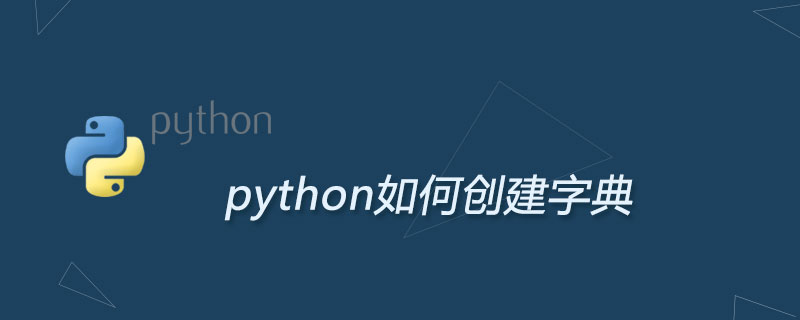How to create a dictionary in python

python dictionary definition
Dictionary is another mutable container model and can store any type of object.
Each key-value key=>value pair in the dictionary is separated by colon :. Each key-value pair is separated by comma,. The entire dictionary is included in curly braces {}. The format is as follows:
d = {key1 : value1, key2 : value2 }The key is generally unique. If the last key-value pair is repeated, the previous one will be replaced. The value does not need to be unique.
>>>dict = {'a': 1, 'b': 2, 'b': '3'}
>>> dict['b']
'3'
>>> dict
{'a': 1, 'b': '3'}Other common ways to create a dictionary in Python:
Dynamic assignment of key values
>>> d ={}
>>> d['name'] = 'Allen'
>>> d
{'name': 'Allen'}If needed This method is more appropriate if you dynamically create one field of a dictionary at a time.
Dictionary key-value table
>>> c = dict(name='Allen', age=14, gender='male')
>>> c
{'gender': 'male', 'age': 14, 'name': 'Allen'}Because this form has simple syntax and is less error-prone, it is very popular.
This form requires less code than constants, but the keys must all be strings, so the following code will report an error:
>>> c = dict(name='Allen', age=14, gender='male', 1='abcd') File "<stdin>", line 1 SyntaxError: keyword can't be an expression
Dictionary key value tuple table
>>> e=dict([('name','Allen'),('age',21),('gender','male')])
>>>
>>>
>>> e
{'gender': 'male', 'age': 21, 'name': 'Allen'}This method is useful if you need to gradually build the keys and values into a sequence while the program is running.
The values of all keys are the same or assigned initial values
>>> f=dict.fromkeys(['height','weight'],'normal')>>> f
{'weight': 'normal', 'height': 'normal'}The above is the detailed content of How to create a dictionary in python. For more information, please follow other related articles on the PHP Chinese website!

Hot AI Tools

Undresser.AI Undress
AI-powered app for creating realistic nude photos

AI Clothes Remover
Online AI tool for removing clothes from photos.

Undress AI Tool
Undress images for free

Clothoff.io
AI clothes remover

Video Face Swap
Swap faces in any video effortlessly with our completely free AI face swap tool!

Hot Article

Hot Tools

Notepad++7.3.1
Easy-to-use and free code editor

SublimeText3 Chinese version
Chinese version, very easy to use

Zend Studio 13.0.1
Powerful PHP integrated development environment

Dreamweaver CS6
Visual web development tools

SublimeText3 Mac version
God-level code editing software (SublimeText3)

Hot Topics
 1386
1386
 52
52
 How to solve the permissions problem encountered when viewing Python version in Linux terminal?
Apr 01, 2025 pm 05:09 PM
How to solve the permissions problem encountered when viewing Python version in Linux terminal?
Apr 01, 2025 pm 05:09 PM
Solution to permission issues when viewing Python version in Linux terminal When you try to view Python version in Linux terminal, enter python...
 How to efficiently copy the entire column of one DataFrame into another DataFrame with different structures in Python?
Apr 01, 2025 pm 11:15 PM
How to efficiently copy the entire column of one DataFrame into another DataFrame with different structures in Python?
Apr 01, 2025 pm 11:15 PM
When using Python's pandas library, how to copy whole columns between two DataFrames with different structures is a common problem. Suppose we have two Dats...
 How to teach computer novice programming basics in project and problem-driven methods within 10 hours?
Apr 02, 2025 am 07:18 AM
How to teach computer novice programming basics in project and problem-driven methods within 10 hours?
Apr 02, 2025 am 07:18 AM
How to teach computer novice programming basics within 10 hours? If you only have 10 hours to teach computer novice some programming knowledge, what would you choose to teach...
 How to avoid being detected by the browser when using Fiddler Everywhere for man-in-the-middle reading?
Apr 02, 2025 am 07:15 AM
How to avoid being detected by the browser when using Fiddler Everywhere for man-in-the-middle reading?
Apr 02, 2025 am 07:15 AM
How to avoid being detected when using FiddlerEverywhere for man-in-the-middle readings When you use FiddlerEverywhere...
 How does Uvicorn continuously listen for HTTP requests without serving_forever()?
Apr 01, 2025 pm 10:51 PM
How does Uvicorn continuously listen for HTTP requests without serving_forever()?
Apr 01, 2025 pm 10:51 PM
How does Uvicorn continuously listen for HTTP requests? Uvicorn is a lightweight web server based on ASGI. One of its core functions is to listen for HTTP requests and proceed...
 What are some popular Python libraries and their uses?
Mar 21, 2025 pm 06:46 PM
What are some popular Python libraries and their uses?
Mar 21, 2025 pm 06:46 PM
The article discusses popular Python libraries like NumPy, Pandas, Matplotlib, Scikit-learn, TensorFlow, Django, Flask, and Requests, detailing their uses in scientific computing, data analysis, visualization, machine learning, web development, and H
 How to dynamically create an object through a string and call its methods in Python?
Apr 01, 2025 pm 11:18 PM
How to dynamically create an object through a string and call its methods in Python?
Apr 01, 2025 pm 11:18 PM
In Python, how to dynamically create an object through a string and call its methods? This is a common programming requirement, especially if it needs to be configured or run...
 How to solve permission issues when using python --version command in Linux terminal?
Apr 02, 2025 am 06:36 AM
How to solve permission issues when using python --version command in Linux terminal?
Apr 02, 2025 am 06:36 AM
Using python in Linux terminal...




